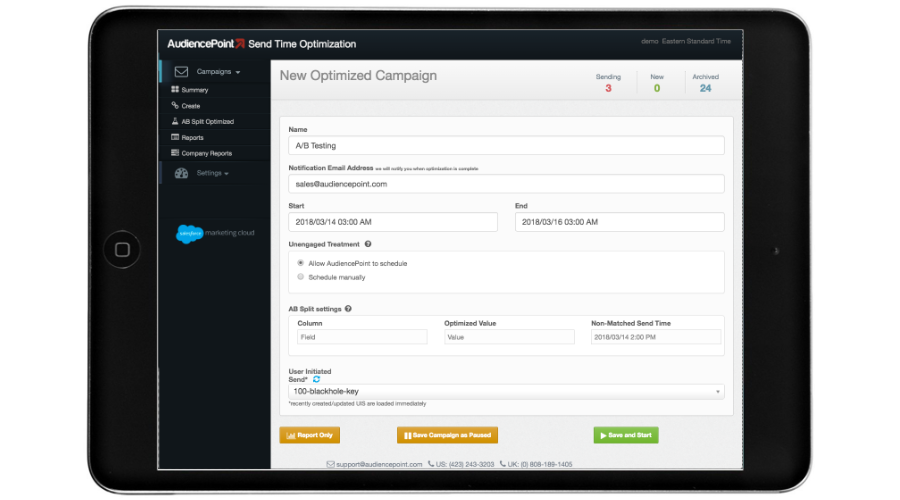AudiencePoint is thrilled to announce our new integration with Klaviyo! AudiencePoint is looking for partners to pilot our...
Email engagement metrics help measure subscribers’ interactions and receptiveness to email content. Several metrics can be used to measure consumer engagement in email marketing, which will help you get an idea of what your audience responds to best and how you can improve your email campaigns.
This article will cover what you should know about engagement metrics, how to track them, and resources that can help.
What Are the Most Important Email Engagement Metrics?
Since there are so many engagement metrics you could track through email analytics tools, figuring out which ones are most important can get confusing. Some engagement metrics that will be important for businesses in any industry are:
- Conversion rate: Conversions are targeted actions you want consumers to take after reading your email, such as making a purchase, signing up for a consultation, installing an app, or starting a free trial. Conversion rate in email marketing is measured by taking the percentage of recipients that convert out of the total number of emails delivered.
- Click-through rate: Click-throughs in email marketing are the percentage of recipients who click a link within the email’s content. Click-through rate is an essential metric to measure how effective calls to action are and how engaging the body content of your email is.
- Open rate: Email opens are a popular metric, since subscribers must open your email for your content to be effective. Open rate is measured by taking the percentage of recipients who open your email out of the total number of emails sent. While open rates are important, it should be noted they have become more difficult to accurately track due to Apple MPP.
- Unsubscribe rate: When consumers sign up for your email list, you want them to stay subscribed and engaged. Unsubscribe rate for email marketing is the percentage of recipients who unsubscribe out of the number of emails delivered. Low unsubscribe rates show your content successfully retains subscribers.
- Bounce rate: You should stay on top of bounces, since they indicate your message was kept from reaching the intended inbox. Bounce rate is measured by taking the percentage of emails bounced out of the total emails sent. Consistently low engagement rates can cause emails to bounce, which further hurts your overall deliverability. It is therefore important to make every effort to keep subscribers engaged.
Tracking these five metrics will give you a good baseline for how your email content is performing. If you’re wondering how to measure and track engagement from emails, there are tools that can help.
How Do You Measure Engagement in an Email?
Email marketing tools and software will help you measure engagement rates for relevant metrics and organize all the information in one place. If you want help measuring email engagement, AudiencePoint is an excellent option.
AudiencePoint will help you track all important metrics and portray the data in a way that’s easy to understand. This data helps you create actionable steps to improve your email strategy. Data from AudiencePoint will help with segmenting email lists, re-engaging inactive subscribers, and improving send times.
What Are Good Email Analytics Metrics?
When tracking analytics for essential email metrics, it’s helpful to know some good numbers to achieve. While good metrics for email marketing can vary by industry, you can use some optimal ranges as benchmarks for good email performance. Good numbers for the most popular metrics are:
- Good email open rate: When excluding Apple MPP opens, you should aim for an open rate of between 17-28%. Open rates in this range show that a good portion of your email list is actively engaged with your content.
- Good email click-through rate: A good click-through rate is between 3-5% for most industries.
- Good email conversion rate: A good conversion rate to aim for is between 2-5%. A 2% conversion rate would be considered above average, whereas a 5% conversion rate is excellent email performance.
- Good email unsubscribe rate: While all companies should aim for a 0% unsubscribe rate, that isn’t always possible. Anything at or below a 0.1% unsubscribe rate is considered good.
- Good email bounce rate: Like unsubscribe rate, a 0% bounce rate would be the best number to aim for, but that won’t always be possible if you have a large email list. Anything below a 0.5% bounce rate is considered good. If you get above a 2% bounce rate, you should try to figure out why as soon as possible and remove addresses that are bouncing from your list.
These numbers will give you a good range to aim for when setting goals for your next email campaign.
What Are the Average Email Marketing Metrics in 2023?
Along with ranges for good metrics, you may also be wondering what the average metrics are to get an idea of common email marketing benchmarks for performance across industries. Average email metrics for the most popular key performance indicators (KPIs) are:
- Average email open rate: The average email open rate is 21.33%, excluding opens from Apple MPP.
- Average email click-through rate: The average email marketing click-through rate is 2.62%.
- Average email conversion rate: The average conversion rate for email marketing is around or slightly below 1.5%.
- Average email unsubscribe rate: The average unsubscribe rate is 0.17%.
- Average email bounce rate: The average email marketing hard bounce rate is 0.4%, and the average email marketing soft bounce rate is 0.58%.
If your numbers are above these averages, it’s a good sign that your emails are high-performing.
How AudiencePoint Can Help with Your Email Marketing
AudiencePoint is a streamlined email insight software that helps improve email marketing metrics through three easy-to-implement tools, Send Time Optimization, Real Time Optimization, and ListFit.
Tools from AudiencePoint take the guesswork out of email marketing. AudiencePoint does this by providing insights into how subscribers interact with their inboxes. This allows you to make adjustments to target your subscribers as effectively as possible.
If AudiencePoint sounds like it would be useful for your business, contact us for more information on getting started.





